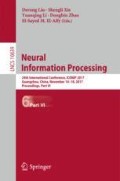Abstract
We propose a biologically plausible computational system using spiking neural networks for object recognition, which processes the data from a temporal contrast address event representation (AER) sensor. The spike-based features are obtained through event-driven Gabor function and LIF neurons. And a time-to-first spike operation (also as a temporal Winner-Take-All (WTA) operation) with lateral reset in the same pooling area is implemented for reducing memory and computational costs. An address lookup table (LUT) is also applied to adjust the feature maps via address mapping and reordering. Then, the extracted spike feature patterns are classified by tempotron neurons. Our system can not only capture temporal visual information, but also learn features entirely based on the timing spikes information. Experiments conducted on two AER datasets have proved its efficiency for object recognition.
Access this chapter
Tax calculation will be finalised at checkout
Purchases are for personal use only
References
Indiveri, G., Linaresbarranco, B., Hamilton, T.J., Van, S.A., Etiennecummings, R., Delbruck, T., Liu, S.C., Dudek, P., Häfliger, P., Renaud, S.: Neuromorphic silicon neuron circuits. Front. Neurosci. 5(5), 73 (2011)
Posch, C., Matolin, D., Wohlgenannt, R.: A QVGA 143 dB dynamic range frame-free PWM image sensor with lossless pixel-level video compression and time-domain CDS. IEEE J. Solid State Circ. 46(1), 259–275 (2010)
Lichtsteiner, P., Posch, C., Delbruck, T.: A 128 \(\times \)128 120 dB 15\(\mu \)s latency asynchronous temporal contrast vision sensor. IEEE J. Solid State Circ. 43(2), 566–576 (2008)
Brandli, C., Berner, R., Yang, M., Liu, S.C., Delbruck, T.: A 240 \(\times \) 180 130 dB 3\(\upmu \) s latency global shutter spatiotemporal vision sensor. IEEE J. Solid State Circ. 49(10), 2333–2341 (2014)
Chen, S., Martini, B., Culurciello, E.: A bio-inspired event-based size and position invariant human posture recognition algorithm. In: IEEE International Symposium on Circuits and Systems, vol. 9, no. 4, pp. 775–778 (2009)
Camunas-Mesa, L., Zamarreno-Ramos, C., Linares-Barranco, A., Acosta-Jimenez, A.J., Serrano-Gotarredona, T., Linares-Barranco, B.: An event-driven multi-kernel convolution processor module for event-driven vision sensors. IEEE J. Solid State Circ. 47(2), 504–517 (2012)
Indiveri, G., Liu, S.C.: Memory and information processing in neuromorphic systems. Proc. IEEE 103(8), 1379–1397 (2015)
Memmesheimer, R.M., Rubin, R., Ölveczky, B.P., Sompolinsky, H.: Learning precisely timed spikes. Neuron 82(4), 925–938 (2014)
Yu, Q., Tang, H., Tan, K.C., Li, H.: Rapid feedforward computation by temporal encoding and learning with spiking neurons. IEEE Trans. Neural Netw. Learn. Syst. 24(10), 1539–1552 (2013)
Bichler, O., Querlioz, D., Thorpe, S.J., Bourgoin, J.P., Gamrat, C.: Extraction of temporally correlated features from dynamic vision sensors with spike-timing-dependent plasticity. Neural Netw. 32(2), 339–348 (2012)
Wang, H., Xu, J., Gao, Z., Lu, C., Yao, S., Ma, J.: An event-based neurobiological recognition system with orientation detector for objects in multiple orientations. Front. Neurosci. 10, 498 (2016)
Zhao, B., Ding, R., Chen, S., Linaresbarranco, B., Tang, H.: Feedforward categorization on aer motion events using cortex-like features in a spiking neural network. IEEE Trans. Neural Netw. Learn. Syst. 26(9), 1963–1978 (2015)
Orchard, G., Meyer, C., Etienne-Cummings, R., Posch, C., Thakor, N., Benosman, R.: HFirst: a temporal approach to object recognition. IEEE Trans. Pattern Anal. Mach. Intell. 37(10), 2028–2040 (2015)
Tsitiridis, A., Conde, C., Diego, I.M.D., Saez, J., Gomez, J.R., Cabello, E.: Gabor feature processing in spiking neural networks from retina-inspired data. In: International Joint Conference in Neural Networks, pp. 1–8 (2015)
Gerstner, W., Kistler, W.M.: Spiking Neuron Models: Single Neurons, Populations, Plasticity. Cambridge University Press, New York (2002)
Gütig, R., Sompolinsky, H.: The Tempotron: a neuron that learns spike timing-based decisions. Nat. Neurosci. 9(3), 420–428 (2006)
Dayan, P., Abbott, L.F.: Theoretical neuroscience: computational and mathematical modeling of neural systems. Q. Rev. Biol. 15, 154–155 (2005)
Zhao, B., Chen, S., Tang, H.: Bio-inspired categorization using event-driven feature extraction and spike-based learning. In: International Joint Conference on Neural Networks, pp. 3845–3852 (2014)
Orchard, G., Jayawant, A., Cohen, G.K., Thakor, N.: Converting static image datasets to spiking neuromorphic datasets using saccades. Front. Neurosci. 9, 178 (2015)
Hu, J., Tang, H., Tan, K.C., Li, H.: How the brain formulates memory: a spatio-temporal model. IEEE Comput. Intell. Mag. 11(2), 56–68 (2016)
Acknowledgments
This work was supported by the National Natural Science Foundation of China under grant number 61673283.
Author information
Authors and Affiliations
Corresponding author
Editor information
Editors and Affiliations
Rights and permissions
Copyright information
© 2017 Springer International Publishing AG
About this paper
Cite this paper
Ma, Y., Xiao, R., Tang, H. (2017). An Event-Driven Computational System with Spiking Neurons for Object Recognition. In: Liu, D., Xie, S., Li, Y., Zhao, D., El-Alfy, ES. (eds) Neural Information Processing. ICONIP 2017. Lecture Notes in Computer Science(), vol 10639. Springer, Cham. https://doi.org/10.1007/978-3-319-70136-3_48
Download citation
DOI: https://doi.org/10.1007/978-3-319-70136-3_48
Published:
Publisher Name: Springer, Cham
Print ISBN: 978-3-319-70135-6
Online ISBN: 978-3-319-70136-3
eBook Packages: Computer ScienceComputer Science (R0)

